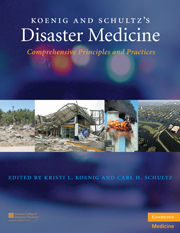Crossref Citations
This Book has been
cited by the following publications. This list is generated based on data provided by Crossref.
Amagai, Teruyoshi
Ichimaru, Satomi
Tai, Mayumi
Ejiri, Yutaka
and
Muto, Atsushi
2014.
Nutrition in the Great East Japan Earthquake Disaster.
Nutrition in Clinical Practice,
Vol. 29,
Issue. 5,
p.
585.
Hong, Wonpyo
Kim, Inbyung
and
Wang, Soon-Joo
2014.
Experiences and lessons of the disaster medical assistance in Korea.
Journal of the Korean Medical Association,
Vol. 57,
Issue. 12,
p.
999.
Teo, Kok Ann Colin
Chong, Tse Feng Gabriel
Liow, Min Han Lincoln
and
Tang, Kong Choong
2016.
Medical Support for Aircraft Disaster Search and Recovery Operations at Sea: the RSN Experience.
Prehospital and Disaster Medicine,
Vol. 31,
Issue. 3,
p.
294.
Tavakoli, Nahid
Yarmohammadian, MohammadH
Safdari, Reza
and
Keyvanara, Mahmoud
2016.
Health sector readiness for patient tracking in disaster: A literature review on concepts and patterns.
International Journal of Health System and Disaster Management,
Vol. 4,
Issue. 3,
p.
75.
Kim, Kyeong Han
Jang, Soobin
Lee, Ju Ah
Jang, Bo-Hyoung
Go, Ho-Yeon
Park, Sunju
Jo, Hee-Guen
Lee, Myeong Soo
and
Ko, Seong-Gyu
2017.
Experiences Providing Medical Assistance during the Sewol Ferry Disaster Using Traditional Korean Medicine.
Evidence-Based Complementary and Alternative Medicine,
Vol. 2017,
Issue. ,
p.
1.
2017.
Landesman’s Public Health Management of Disasters: The Practice Guide, 4th edition.
Sefrioui, I.
Amadini, R.
Mauro, J.
El Fallahi, A.
and
Gabbrielli, M.
2017.
Survival prediction of trauma patients: a study on US National Trauma Data Bank.
European Journal of Trauma and Emergency Surgery,
Vol. 43,
Issue. 6,
p.
805.
Koenig, Kristi L.
Schultz, Carl H.
Gould Runnerstrom, Miryha
and
Ogunseitan, Oladele A.
2017.
Public Health and Disasters: An Emerging Translational and Implementation Science, Not “Lessons Learned”.
Disaster Medicine and Public Health Preparedness,
Vol. 11,
Issue. 5,
p.
610.
Bazyar, Jafar
Farrokhi, Mehrdad
and
Khankeh, Hamidreza
2019.
Triage Systems in Mass Casualty Incidents and Disasters: A Review Study with A Worldwide Approach.
Open Access Macedonian Journal of Medical Sciences,
Vol. 7,
Issue. 3,
p.
482.
Susilowati, Indri Hapsari
Nakatani, Hiroki
Nugraha, Susiana
Pengpid, Supa
Keawpan, Wonpen
Hasiholan, Bonardo Prayogo
Toai, Nguyen Phuong
Abdeali, Ameerali
Isahak, Marzuki
and
Kamso, Sudijanto
2020.
COVID-19 handling report for pre-case, case (pre-hospital and hospital), and post-case phases in the elderly as vulnerable populations in 6 Asia Pacific countries.
Global Health & Medicine,
Vol. 2,
Issue. 6,
p.
350.
Balsamo, Michela
and
Carlucci, Leonardo
2020.
Italians on the Age of COVID-19: The Self-Reported Depressive Symptoms Through Web-Based Survey.
Frontiers in Psychology,
Vol. 11,
Issue. ,
Øvretveit, John
and
Ohrling, Mikael
2021.
Implementation Science for Managers and Healthcare Organizations Responding to Emergencies.
Global Implementation Research and Applications,
Vol. 1,
Issue. 4,
p.
291.
Zakianis
Lestari, Fatma
Fauzia, Sifa
Fitria, Laila
Zulys, Agustino
Hartono, Budi
Muzanni, Adonis
Satyawardhani, Saraswati A.
Shaw, Rajib
and
Prabowo, Setyo
2023.
Identification of Hazardous Waste Risk Level in Central Java Province, Indonesia.
Sustainability,
Vol. 15,
Issue. 8,
p.
6390.





